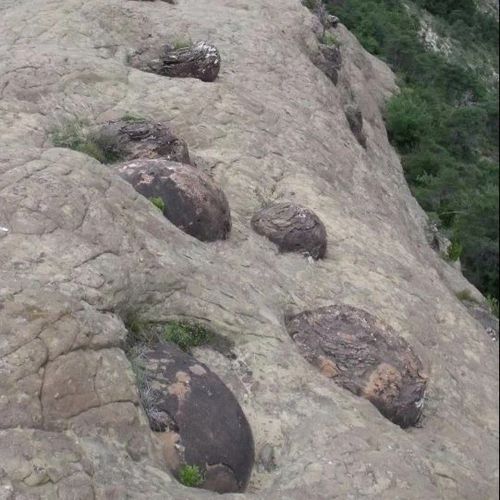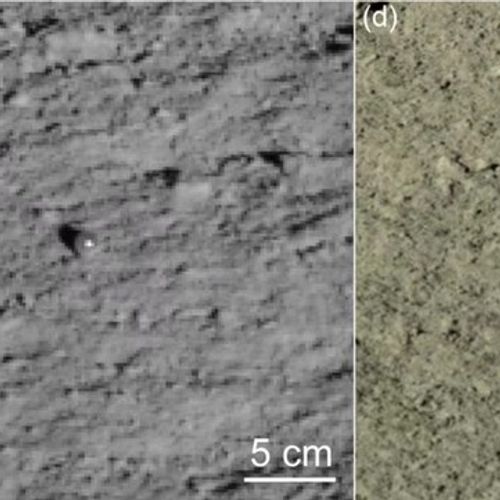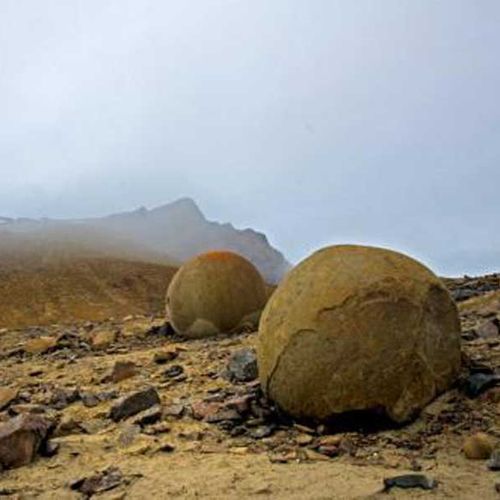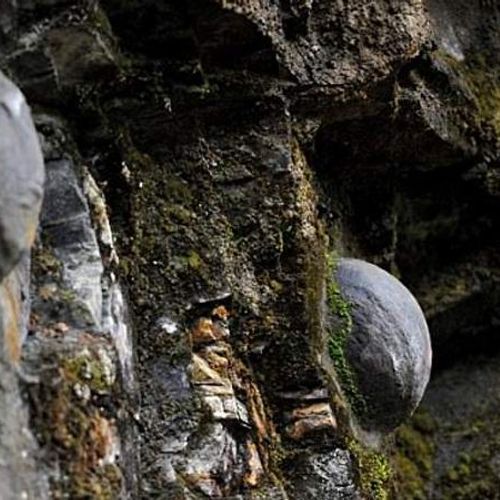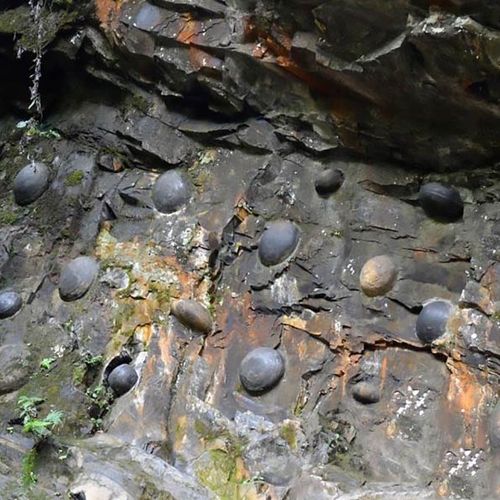
| Added | Tue, 22/03/2022 |
| Источники | |
| Дата публикации | Tue, 22/03/2022
|
| Версии |
On Mount Gandang, located in the southwestern region of China, there is an interesting phenomenon that geologists, researchers and locals have been observing for several decades. In the rocky walls of the base of the mountain, located in Guizhou Province, there is a cliff that the locals call "Chan Dan Ya", which in Mandarin means "egg-laying cliff", due to its ability to "lay" stone "eggs" every 30 years. But where do they come from?
The egg-laying cliff of the mountain is approximately six meters (20 feet) wide and 20 meters (65 feet) long, which is quite small compared to the size of the entire mountain. About once every 30 years, a small rock "lays" a stone egg on its side. As soon as the stone egg breaks off the cliff, it falls to the ground, where it can be found by the first local resident who is lucky enough to stumble upon it.
This phenomenon of laying stone eggs has been observed for hundreds of years. The locals of this region have heard stories of a mountain laying eggs since childhood, and most of them, having grown up, go there to try to find a fallen stone egg. The size of the stone eggs found varies from 20 to 60 cm (7-24 inches) each. They have a dark blue hue and are almost perfectly smooth, which allows them to reflect sunlight at a certain angle after cleaning and polishing. The largest stones, as it turned out, weigh more than 600 pounds (272 kg)!
The nearest village to Chang Dan Ya is Gulu Village, an old district in the Autonomous County of Sandu Shui, where 250,000 Shuis live, which is more than 60% of the population of China. The Shuis are one of the 56 officially recognized ethnic groups in China, they have lived in this region since before the Han Dynasty. Although the region itself is large, Gulu village is actually quite small, with only a few dozen families living in it.
The name Shui can be translated as "water", which is quite appropriate, given their history of life by the water. Whether it's rivers or streams, the Shui people can be found living next to them. At some point in history, several Shuya communities were forced to move to the mountains, where they live to this day, preserving their love of water. Their traditions, folklore and other beliefs revolve around the concept of water. Most of their clothes are painted in shades of blue to match the color of the water. In fact, the Shui language was also developed with the concept of water in mind, as there are ten different words meaning "fish" in their language.
Since the local egg-laying mountain was discovered, locals have reported that more than 100 eggs have been found at the base of the cliff. Currently, about 70 are in the village and are divided between families depending on who found them first. The rest, they said, were either sold or stolen. The inhabitants of Shui believe that stone eggs, born by the egg-bearing mountain, bring good luck and luck, and even sometimes worship them. They can be found in almost all the houses in the village, and they are highly respected by those who collect them, as they are believed to bring prosperity and security to people, animals and homes.
The formation of these mysterious stone eggs is still being studied. Based on current research, it is believed that these eggs and the surrounding rocks in this region were formed in the Cambrian period about 500 million years ago. The Cambrian period was part of the Paleozoic era and is known for the "Cambrian explosion" - a period of time during which, according to the fossil record, most of the main groups of animals on Earth arose and diversified. Geologists suggest that this region was once under water, which may have contributed to the formation of these egg-shaped rocks over time.
It is believed that as a result of the effects of heat and compression on these stone eggs over the past 500 million years, they have become considered metamorphic rocks. Metamorphic rocks are formed from existing igneous or sedimentary rocks that are subjected to intense heating and pressure underground for a long period of time.
Professor Xu Ronhua from the Institute of Geology and Geophysics at the Chinese Academy of Sciences claims that the stone eggs are made of silicon dioxide, which must have been present in this region in the Cambrian period. If this is true, then, according to him, the egg-shaped shape of the stones makes sense - since the sphere has a small surface area compared to other forms, silicon dioxide particles had to bond in the shape of a sphere in water before being compressed into metamorphic rocks.
Being under water itself also contributed to the roundness and smoothness of the stones. As the stones move along the ocean floor under the influence of the surrounding currents and animals, they wear away, acquiring a smoother and more rounded shape. The same concept applies to the manufacture of ocean glass or home tumblers for stones.
Silicon dioxide is present in many rocks, and in some rocks it is more than in others. Fibrous varieties of silicon dioxide are called chalcedony. Examples of chalcedony are agate, bloodstone and onyx. Quartz and moganite also consist of silicon dioxide, but each of them has a different physical crystal structure than all the other examples. It is not entirely clear why stone eggs are black, and not transparent, milky or pastel, like other silicon stones, but scientists are actively trying to uncover further secrets of the composition of these mysterious stone eggs.
The area surrounding the rock outside the eggs, however, is different. The cliff itself does not consist of metamorphic rock. Instead, the surrounding rock consists of calcareous rock, which is considered sedimentary rock. Sedimentary rocks can be found closer to the surface of the earth, they consist of compressed sediments such as sand, soil or small pieces of rock. Examples of sedimentary rocks are limestone, sandstone and shale. These sedimentary rocks surrounding the stone eggs may have contributed to their compression and separation over the past 500 million years.
Although it may seem that stone eggs are formed over 30 years and are "born" on the side of a cliff, in fact this is not the case. As mentioned earlier, it is believed that these stone eggs have existed for about 500 million years. Over time, the rocky slope of Chang Dan Ya has worn out as a result of weathering and erosion. Temperature changes and the effects of wind, water, ice, gravity, humans and animals can eventually destroy even the largest rocks, including mountains.
Since the composition of the stone eggs and the surrounding rock differs from each other, it is believed that the surrounding rock simply wears out faster than the stone eggs themselves. This is because calcareous rocks are destroyed faster than metamorphic ones. Calcareous rocks consist mainly of calcium oxide, carbon dioxide and magnesium oxide.
They may also contain trace amounts of aluminum, iron, silicon and water. The surrounding sedimentary calcareous rock, due to its composition, collapses faster, eventually exposing stone eggs of a different composition. Since metamorphic stone eggs do not collapse along with the surrounding cliff, they fall out of it as they wear out.
Locals in Gulu estimated that it takes about 30 years for each stone egg to be "laid" by the mountain from the moment it first appears in the rock until it falls to the ground. A stone egg that is just emerging may lie for another 30 years before the rock erodes so much that it falls, and a stone egg that has already been partially laid may lie for only 10-20 years. Since all the stone eggs are located in different places of the rock, theoretically the egg can fall at any moment for the next lucky person who finds it.
As the mountain continues to collapse, stone eggs may begin to appear on the paths that Shui locals and other tourists often walk along. If this happens, moving along paths or on horseback may be difficult, and measures will have to be taken to physically remove or destroy protruding eggs.
What awaits the famous egg-laying mountain? As the slopes of the mountain will eventually collapse, more and more stone eggs will come out of the rock and fall to the ground. In addition, eggs can begin to protrude on the top of the mountain, since, as already mentioned, it is eroded by pedestrian traffic. Geologists can't say exactly how many eggs are left in the mountain, but theoretically they could be all over the mountain if there was enough silicon dioxide in the region during the Cambrian period. Ultimately, no one will know about it until the mountain runs out of stone eggs-if it happens at all.
Over the next few thousand years, the mountain will continue to erode into the soil, leaving behind these eggs. If the eggs are no longer collected, they will remain on the ground, where they will also collapse and turn into sediment, from which new sedimentary rocks will eventually be formed. This is the rock cycle that we all learned about in elementary school. However, without being exposed to weathering factors such as soil, wind, water and ice, stone eggs can be preserved by a person much longer if they continue to be carefully collected.
Believe it or not, this particular cliff at the base of Chan Dan Ya is not the only area that "lays eggs". In other, less visited places of the mountain, outcrops and egg emissions are also observed, which suggests that the whole mountain is full of them. If this is true, then locals may see more of these unique stones over the generations.
Families in other nearby areas can also start collecting these eggs as they become available and use them for trade, tourism or religious purposes. Those who live on the other side of the mountain and have never observed the phenomenon of egg laying before can begin to observe it themselves.
Although Mount Gandang was the first place where these stone eggs were discovered, it is possible that other places may exist in unexplored mountainous areas. It is also possible that in the future the mountains may contain more stone eggs. Currently, our oceans contain 30 ppb (parts per billion) of silicon dioxide, and the earth's crust is 59% silicon dioxide.
Since such a large amount of silicon is still present both in the earth and in the oceans, it is quite possible that newly created eggs may be in future mountains in a few million years. Although we won't personally see these mountains laying eggs, perhaps those who see it will be as fascinated by it as we are.
Новости со схожими версиями
Log in or register to post comments


